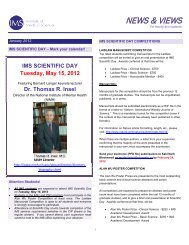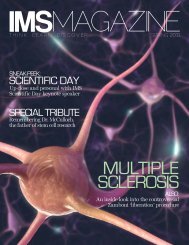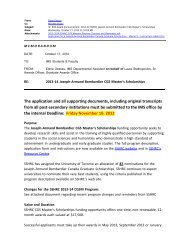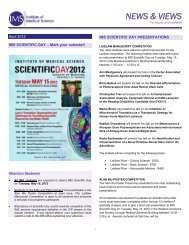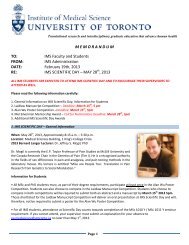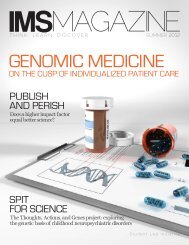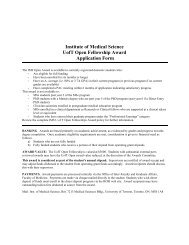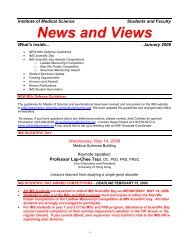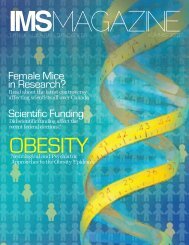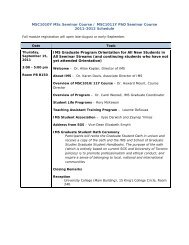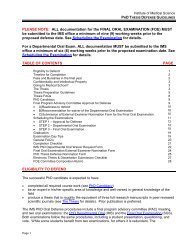Fall 2011 - Institute of Medical Science - University of Toronto
Fall 2011 - Institute of Medical Science - University of Toronto
Fall 2011 - Institute of Medical Science - University of Toronto
Create successful ePaper yourself
Turn your PDF publications into a flip-book with our unique Google optimized e-Paper software.
SURP RESEARCH FOCUS<br />
Given the rigour <strong>of</strong> their design, are the results<br />
<strong>of</strong> RCTs fool-pro<strong>of</strong>? There are several<br />
examples where the results <strong>of</strong> such trials did<br />
not seem to agree with clinical reality. R<strong>of</strong>ecoxib<br />
is a cyclooxygenase-2 inhibitor whose<br />
use for the treatment <strong>of</strong> arthritis became<br />
widespread after favourable results from<br />
RCTs, only to be taken <strong>of</strong>f the market a few<br />
years later when it was found to increase the<br />
risk <strong>of</strong> cardiovascular complications 6 . Reboxetine<br />
was touted as an effective anti-depressant<br />
until it was discovered that publication<br />
<strong>of</strong> data had been highly selective – once the<br />
complete body <strong>of</strong> data concerning drug efficacy<br />
and safety were evaluated, it was found<br />
that the drug was not only ineffective in the<br />
treatment <strong>of</strong> depression, but harmful 7 .<br />
In the above examples, the reported results<br />
<strong>of</strong> RCTs did not correspond with reality because<br />
<strong>of</strong> bias in trial conduct, analysis, or<br />
publication 6,8 . Unfortunately, the degree to<br />
which this sort <strong>of</strong> bias affects the published<br />
results <strong>of</strong> any RCT is unknown.<br />
Methods to evaluate bias in RCTs are important<br />
for physicians who use results <strong>of</strong> RCTs<br />
to guide treatment decisions. There is no<br />
objective gold standard to evaluate bias because<br />
it is difficult to measure and can only<br />
be estimated 9 . An optimal assessment <strong>of</strong> bias<br />
requires unrestricted access to both the procedures<br />
used by the trial researchers and the<br />
complete raw data, but such access is very<br />
difficult to attain 10 . Nevertheless, there are<br />
Adverse<br />
Event<br />
Not in results<br />
table (NOT R)<br />
In results table<br />
(R)<br />
Not in abstract<br />
(NOT A)<br />
In Abstract (A)<br />
Not in discussion<br />
(NOT D)<br />
In discussion<br />
(D)<br />
Not in concluding<br />
statement<br />
(NOT C)<br />
In concluding<br />
statement (C)<br />
certain criteria that can be used to estimate<br />
the degree <strong>of</strong> bias in RCTs.<br />
One criterion used to assess bias is the systematic<br />
evaluation <strong>of</strong> the reporting <strong>of</strong> trial<br />
endpoints. Endpoints are outcomes being<br />
measured by the trial, which may include<br />
overall survival, disease-free survival, quality<br />
<strong>of</strong> life and response rate, among others. RCTs<br />
are designed to recruit a predefined number<br />
<strong>of</strong> people, and to determine if a statistically<br />
significant difference in primary endpoints<br />
exists 9 . This does not mean that significant<br />
differences in other endpoints are not important,<br />
but statistical tests applied to them are<br />
subject to misinterpretation 8 . The evaluation<br />
<strong>of</strong> secondary endpoints should therefore be<br />
regarded as exploratory. If a publication does<br />
not clearly indicate the results relating to the<br />
primary endpoint <strong>of</strong> the trial and does not<br />
describe the results <strong>of</strong> secondary endpoints<br />
in its concluding statements, it is biased 8 .<br />
Another possible criterion for the systematic<br />
evaluation <strong>of</strong> bias is the reporting <strong>of</strong> adverse<br />
events (AEs) associated with the experimental<br />
treatment. We developed a method to<br />
evaluate this bias, which employed a hierarchy<br />
<strong>of</strong> AE reporting based on the sections <strong>of</strong><br />
a publication where AEs are most likely to be<br />
read (Figure 1).<br />
In each <strong>of</strong> 168 publications <strong>of</strong> RCTs evaluating<br />
breast cancer treatment, every reported<br />
moderate to severe AE that was statistically<br />
Not in<br />
discussion<br />
(NOT D)<br />
In discussion<br />
(D)<br />
Not in<br />
discussion<br />
(NOT D)<br />
In discussion<br />
(D)<br />
NOT R<br />
R + (NOT A) +<br />
(NOT D)<br />
R + (NOT A) + D<br />
R + A + (NOT C) +<br />
(NOT D)<br />
R + A + (NOT C) +<br />
D<br />
R + A + C +<br />
(NOT D)<br />
R + A + C + D<br />
Inadequate<br />
reporting <strong>of</strong><br />
adverse events<br />
Less adequate<br />
reporting <strong>of</strong><br />
adverse events<br />
Adequate<br />
reporting <strong>of</strong><br />
adverse events<br />
Figure 1. Hierarchy <strong>of</strong> adverse events (AE) reporting. One possible hierarchy scheme is shown, where<br />
the top represents the least adequate reporting <strong>of</strong> a moderate to severe AE.<br />
different between the experimental and control<br />
arms received a score based on its position<br />
in the hierarchy. This score was used to<br />
cluster publications that had a similar reporting<br />
<strong>of</strong> AEs. With a large enough sample <strong>of</strong><br />
publications, individual clusters could be defined<br />
where each represents a certain degree<br />
<strong>of</strong> bias. A survey querying oncologists about<br />
where they most commonly see the reporting<br />
<strong>of</strong> AEs in publications <strong>of</strong> RCTs has been designed<br />
to test the validation <strong>of</strong> the hierarchy<br />
in Figure 1. The results are pending.<br />
There is substantial evidence that bias exists<br />
in the conduct, analysis, and reporting<br />
<strong>of</strong> RCTs 8-10 . A measure <strong>of</strong> the degree <strong>of</strong> this<br />
bias would be <strong>of</strong> great help to those who must<br />
decide how much to trust the results <strong>of</strong> these<br />
RCTs, especially when deciding whether<br />
to apply the results to patients. Although<br />
no gold standard exists that can be used to<br />
evaluate the degree <strong>of</strong> bias in a publication,<br />
methods are being developed for the purpose<br />
<strong>of</strong> estimating this bias with the hope <strong>of</strong> minimizing<br />
its effect on clinical decision-making.<br />
References<br />
1. Concato J, Shah N, Horwitz RI. Randomized controlled<br />
trials, observational studies, and the hierarchy <strong>of</strong><br />
research designs. NEJM 2000; 342(25): 1887-92.<br />
2. FDA approval <strong>of</strong> new cancer treatment uses for marketed<br />
drug and biological products. Food and Drug<br />
Administration; c1998. Available from: http://www.fda.<br />
gov/downloads/Drugs/GuidanceComplianceRegulatoryInformation/Guidances/ucm071657.pdf<br />
(accessed<br />
August <strong>2011</strong>)<br />
3. Altman DG, Bland JM. How to randomize. BMJ 1999;<br />
319: 703-4.<br />
4. Schulz KF, Grimes DA. Allocation concealment in<br />
randomised trials: defending against deciphering. Lancet<br />
2002; 359: 614-8.<br />
5. Schulz KF, Grimes DA. Blinding in randomised trials:<br />
hiding who got what. Lancet 2002; 359: 696-700.<br />
6. Roth-Cline MD. Clinical trials in the wake <strong>of</strong> Vioxx.<br />
Circulation 2006; 113: 2253-59.<br />
7. Eyding D, Lelgemann M, Grouven U, Harter M,<br />
Kromp M, Kaiser T, Kerekes MF, Gerken M, Wieseler<br />
B. Reboxetine for acute treatment <strong>of</strong> major depression:<br />
systematic review and meta-analysis <strong>of</strong> published<br />
and unpublished placebo and selective serotonin reuptake<br />
inhibitor controlled trials. BMJ 2010; 341: c4737<br />
doi:10.1136/bmj.c4737<br />
8. Boutron I, Dutton S, Ravaud P, Altman DG. Reporting<br />
and interpretation <strong>of</strong> randomized controlled trials<br />
with statistically nonsignificant results for primary outcomes.<br />
JAMA 2010; 303(20): 2058-64.<br />
9. Chan AW, Hrobjartsson A, Haahr MT, Gotzsche PC,<br />
Altman DG. Empirical evidence for selective reporting<br />
<strong>of</strong> outcomes in randomized trials. JAMA 2004; 291(20):<br />
2457-65.<br />
10. Chan AW. Bias, spin, and misreporting: time for<br />
full access to trial protocols and results. PLoS Medicine<br />
2008; 5(11): 1533-35.<br />
IMS MAGAZINE FALL <strong>2011</strong> PROSTATE CANCER | 30



